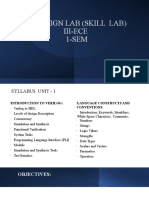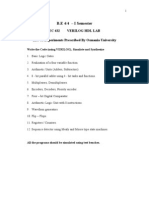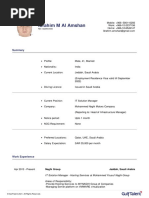Lab 4 Verilog Gate Level Modelling
Uploaded by
safdarmunir070Lab 4 Verilog Gate Level Modelling
Uploaded by
safdarmunir070Sir Syed CASE Institute of Technology, Islamabad
EE2401 Digital Logic Design
Lab No. 4
Name of Student: Roll No. :
Date of Experiment: Report submitted on:
Marks obtained: Instructor’s Signature:
Instructor: Engr. Safdar Munir
Introduction to Verilog, Implementation of All Logic Gates
in Verilog.
Hardware Description Language (HDL)
Objectives
a. To understand the concept of Hardware Description Language.
b. To understand and learn syntax of Verilog HDL.
c. To learn how to use Modelsim
d. To implement all logic gates using Verilog
Introduction:
A hardware description language (HDL) used in the design, verification, and implementation of
digital logic chips. It used to describe electronic circuits and digital systems. In practice it is
generally used for simulating, testing, and programming PLD (programmable logic devices) or
other similar hardware.
On paper it is almost impossible to check the working of a circuit containing hundreds or
thousands of gates.
A hardware description language is used for describing and testing logic circuits. It is a text based way to
talk about designs.
Verilog HDL:
Verilog is very much similar to C, it is used by hardware designers in industry and academia. It is
an easy to learn language. Verilog HDL although looks similar to C but it is not a software
programming language, rather it is a hardware description language. It is important for verilog
programmers to know about the hardware.
Simulator:
The simulator that we will use is the ModelSim simulator.
------------------------------------------------------------------------------------------------------------------------
Verilog Program
A verilog program consists of two parts;
1. Device Under Test (DUT).
2. Stimulus
Digital Logic Design Lab (EE-2401) 2
1. DUT
A digital design coded in Verilog consists of one or several modules. The contents of a module
are also critical from synthesis perspective. A module is the basic building block in Verilog.
Verilog •C/C++
void main()
module name (portlist); {
// data types declaration // data types declaration
.. ..
… …
// data manipulation // data manipulation
endmodule }
Modules start with keyword module and end with keyword endmodule.
Module for AND gate
module my_and(in1,in2,o);
input in1,in2;
output o;
and aa(o,in1,in2);
endmodule
Module Ports:
These are similar to the pins on chip.
Ports provide a way of communication with outside world.
The Ports of a module can be input, output or inout.
Module Declarations:
METHOD # 1 METHOD # 2
module name (in1, in2,out); module name (input in1,in2,
output out);
input in1,in2;
output out;
endmodule endmodule
2. Stimulus / Test Bench:
To provide input values to our design and to get the required output, we need a test bench. It is
written in separate or same file in which main module has been designed.
Digital Logic Design Lab (EE-2401) 3
The following is an example of a stimulus in verilog.
Stimulus for AND gate:
module stim_and;
reg in1,in2;
wire o ;
my_and n1 (in1,in2,o);
initial
begin
in1=0;
in2=0;
#20 in1=0;
in2=1;
#20 in1=1;
in2=0;
#20 in1=1;
in2=1;
end
endmodule.
------------------------------------------------------------------------------------------------------------------
Constants
A constant in Verilog can be of any size and it can be written in decimal, binary, octal or
hexadecimal format. The decimal is the default format. A number 13 can be written in different
format as shown.
Decimal (default)
w = 12; r = 14;
Binary
w = 4’b1100; r = 4’b1110;
Time Control
The programmer can insert delays in the code by placing #<number>. On encountering this
statement, the simulation halts the execution of the statement until <number> time units have
passed. The Control is released from that statement or block so that other processes can
execute.
Initial block:
Initial block executes only once starting at t=0 simulation time.
Digital Logic Design Lab (EE-2401) 4
Initial block starts with initial keyword, if multiple statements are used in an initial block, they
are enclosed within begin and end Verilog constructs.
1. This block is used only in stimulus.
2. Simulator Kernel executes initial block until the execution come to a #delay operator.
Then the execution is suspended and the simulator kernel places the execution of this
block in the event list for delay-time units in the future.
3. After completing delay-time units, the execution is resumed where it was left off.
-----------------------------------------------------------------------------------------------------------------
Levels of Abstraction
Verilog is a hardware description language. The HW can be described at several levels of details.
To capture these details Verilog provides the designer the following four levels of abstractions:
1. Switch level
2. Gate level
3. Dataflow level
4. Behavioral or algorithmic level
-----------------------------------------------------------------------------------------------------------------------------
Gate Level:
Gate level modeling is also a low level of abstraction and not used for coding design at RTL
(Register Transfer Level) level. Our interest in this level is from the fact that the Synthesis tools
compile high level code and generate code at gate level. The code at gate level is built from
Verilog primitives. These primitives are built-in gate-level models of basic functions. These basic
functions include nand, nor, and, or, xor, not etc. Modeling at this level requires describing the
circuit using logic gates. This description looks much like an implementation of a circuit in logic
design course. Delays can also be modeled in this level. A typical gate instantiation is
and instance-name (out, in1, in2, in3, …)
First parameter in the primitive, out, is always one-bit output following by several one bit
inputs in1, in2, in3.
In Verilog, #delay specifies the delay from input to output of the gate.
Example
Digital Logic Design Lab (EE-2401) 5
1. 2×1 MUX
------------------------- MAIN MODULE ---------------------------
module my_mux21_gate(in1,in2,sel,out);
input in1,in2,sel;
output out;
wire out1,out2,out3;
not aa(out3,sel);
and bb(out1,in1,out3);
and cc(out2,sel,in2);
or dd(out,out1,out2);
endmodule
----------------------- STIMULUS -------------------------------
module stim_mux21_gate;
reg in1,in2,sel;
wire out;
my_mux21_gate rr(in1,in2,sel,out);
initial
begin
in1=0;
in2=1;
sel=0;
#20 in1=1;
in2=0;
sel=0;
#20 in1=1;
in2=0;
sel=1;
end
endmodule
-------------------------------------------------------------------
Digital Logic Design Lab (EE-2401) 6
Output
Example
Digital Logic Design Lab (EE-2401) 7
Code
---------------------MAIN MODULE ---------------------------------
module my_circuit( a,b,o);
input a,b;
output o;
wire o1,o2;
nand aa(o1,a,b);
or bb(o2,a,b);
and cc(o,o1,o2);
endmodule
-------------------- STIMULUS ----------------------------------
module stim_circuit;
reg a,b;
wire o;
my_circuit dd(a,b,o);
initial
begin
a=0;
b=0;
#20 a=0;
b=1;
#20 a=1;
b=0;
#20 a=1;
b=1;
end
endmodule
Digital Logic Design Lab (EE-2401) 8
Output
Digital Logic Design Lab (EE-2401) 9
LAB TASKS
1. Implement XOR with gate level modeling.
2. Implement the following circuit using gate level modeling.
A B C Q
1 0 1 0
0 0 1 1
1 1 1 1
3. Implement the following circuit using gate level modeling.
A B C D O
0 0 0 0 0
0 0 0 1 1
1 0 1 0 0
Digital Logic Design Lab (EE-2401) 10
Digital Logic Design Lab (EE-2401) 11
You might also like
- Verilog HDL: A Guide To Digital Design DS TH I and SynthesisNo ratings yetVerilog HDL: A Guide To Digital Design DS TH I and Synthesis62 pages
- EE-421 Digital System Design Lab (Fall 2016) : Or, NotNo ratings yetEE-421 Digital System Design Lab (Fall 2016) : Or, Not12 pages
- Basic Logic Design With Verilog HDL: Combinational CircuitsNo ratings yetBasic Logic Design With Verilog HDL: Combinational Circuits67 pages
- Birla Institute of Technology & Science, Pilani Lab Sheet - 1No ratings yetBirla Institute of Technology & Science, Pilani Lab Sheet - 17 pages
- Verilog Introduction by IIT Kharagpur Profs - PptsNo ratings yetVerilog Introduction by IIT Kharagpur Profs - Ppts194 pages
- ENEL111 Digital Electronics: Richard Nelson G.1.29No ratings yetENEL111 Digital Electronics: Richard Nelson G.1.2938 pages
- Unit-V Verilog Hardware Description LanguageNo ratings yetUnit-V Verilog Hardware Description Language73 pages
- Introduction To Verilog HDL: Presented by K.SwathiNo ratings yetIntroduction To Verilog HDL: Presented by K.Swathi35 pages
- Week 1-2 Introduction To Hardware Description LanguageNo ratings yetWeek 1-2 Introduction To Hardware Description Language23 pages
- Basic Logic Design With Verilog HDL:: Gate-Level Design On Combinational CircuitsNo ratings yetBasic Logic Design With Verilog HDL:: Gate-Level Design On Combinational Circuits101 pages
- Digital Circuit Verification Hardware Descriptive Language VerilogNo ratings yetDigital Circuit Verification Hardware Descriptive Language Verilog17 pages
- Study of Synthesis Tools Expt - No.1 Aim:: Vlsi Lab ManualNo ratings yetStudy of Synthesis Tools Expt - No.1 Aim:: Vlsi Lab Manual17 pages
- Hardware Description Language (HDL) What Is The Need For Hardware Description Language? Model, Represent, and Simulate Digital HardwareNo ratings yetHardware Description Language (HDL) What Is The Need For Hardware Description Language? Model, Represent, and Simulate Digital Hardware26 pages
- Build Logic Gates with Universal NAND: CMOS and TTL in ActionFrom EverandBuild Logic Gates with Universal NAND: CMOS and TTL in ActionNo ratings yet
- PLC: Programmable Logic Controller – Arktika.: EXPERIMENTAL PRODUCT BASED ON CPLD.From EverandPLC: Programmable Logic Controller – Arktika.: EXPERIMENTAL PRODUCT BASED ON CPLD.No ratings yet
- IEPE (Integrated Electronics Piezo-Electric) - KistlerNo ratings yetIEPE (Integrated Electronics Piezo-Electric) - Kistler2 pages
- Hong Kong Marriage and Family Therapy Association Limited: Name of Applicant: (English) ( )No ratings yetHong Kong Marriage and Family Therapy Association Limited: Name of Applicant: (English) ( )10 pages
- Reading Comprehension Practice Passages Competitive Exams: Airbus Crisis Over100% (1)Reading Comprehension Practice Passages Competitive Exams: Airbus Crisis Over3 pages
- Pretest Letter To Parents For ScholasticNo ratings yetPretest Letter To Parents For Scholastic2 pages
- CSE3009 - PARALLEL-AND-DISTRIBUTED-COMPUTING - LTP - 1.0 - 8 - Parallel and Distributed ComputingNo ratings yetCSE3009 - PARALLEL-AND-DISTRIBUTED-COMPUTING - LTP - 1.0 - 8 - Parallel and Distributed Computing2 pages
- TB2-SDC - VPM210171-00100-M-M1B-PFD-0001 Rev0No ratings yetTB2-SDC - VPM210171-00100-M-M1B-PFD-0001 Rev023 pages
- The Secret To Marketing Simulations by ConcentricNo ratings yetThe Secret To Marketing Simulations by Concentric41 pages
- Jose Daniel G. Asuncion: 2FB Dapitan Regency Dapitan St. Sampaloc, Manila 20:00No ratings yetJose Daniel G. Asuncion: 2FB Dapitan Regency Dapitan St. Sampaloc, Manila 20:003 pages
- Verilog HDL: A Guide To Digital Design DS TH I and SynthesisVerilog HDL: A Guide To Digital Design DS TH I and Synthesis
- EE-421 Digital System Design Lab (Fall 2016) : Or, NotEE-421 Digital System Design Lab (Fall 2016) : Or, Not
- Basic Logic Design With Verilog HDL: Combinational CircuitsBasic Logic Design With Verilog HDL: Combinational Circuits
- Birla Institute of Technology & Science, Pilani Lab Sheet - 1Birla Institute of Technology & Science, Pilani Lab Sheet - 1
- Verilog Introduction by IIT Kharagpur Profs - PptsVerilog Introduction by IIT Kharagpur Profs - Ppts
- ENEL111 Digital Electronics: Richard Nelson G.1.29ENEL111 Digital Electronics: Richard Nelson G.1.29
- Introduction To Verilog HDL: Presented by K.SwathiIntroduction To Verilog HDL: Presented by K.Swathi
- Week 1-2 Introduction To Hardware Description LanguageWeek 1-2 Introduction To Hardware Description Language
- Basic Logic Design With Verilog HDL:: Gate-Level Design On Combinational CircuitsBasic Logic Design With Verilog HDL:: Gate-Level Design On Combinational Circuits
- Digital Circuit Verification Hardware Descriptive Language VerilogDigital Circuit Verification Hardware Descriptive Language Verilog
- Study of Synthesis Tools Expt - No.1 Aim:: Vlsi Lab ManualStudy of Synthesis Tools Expt - No.1 Aim:: Vlsi Lab Manual
- Hardware Description Language (HDL) What Is The Need For Hardware Description Language? Model, Represent, and Simulate Digital HardwareHardware Description Language (HDL) What Is The Need For Hardware Description Language? Model, Represent, and Simulate Digital Hardware
- Build Logic Gates with Universal NAND: CMOS and TTL in ActionFrom EverandBuild Logic Gates with Universal NAND: CMOS and TTL in Action
- PLC: Programmable Logic Controller – Arktika.: EXPERIMENTAL PRODUCT BASED ON CPLD.From EverandPLC: Programmable Logic Controller – Arktika.: EXPERIMENTAL PRODUCT BASED ON CPLD.
- IEPE (Integrated Electronics Piezo-Electric) - KistlerIEPE (Integrated Electronics Piezo-Electric) - Kistler
- Hong Kong Marriage and Family Therapy Association Limited: Name of Applicant: (English) ( )Hong Kong Marriage and Family Therapy Association Limited: Name of Applicant: (English) ( )
- Reading Comprehension Practice Passages Competitive Exams: Airbus Crisis OverReading Comprehension Practice Passages Competitive Exams: Airbus Crisis Over
- CSE3009 - PARALLEL-AND-DISTRIBUTED-COMPUTING - LTP - 1.0 - 8 - Parallel and Distributed ComputingCSE3009 - PARALLEL-AND-DISTRIBUTED-COMPUTING - LTP - 1.0 - 8 - Parallel and Distributed Computing
- Jose Daniel G. Asuncion: 2FB Dapitan Regency Dapitan St. Sampaloc, Manila 20:00Jose Daniel G. Asuncion: 2FB Dapitan Regency Dapitan St. Sampaloc, Manila 20:00

























































































